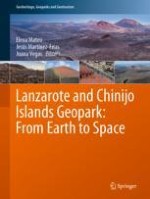In general, the geological aspects of a territory, despite being a determining factor in its own physical constitution, are perceived far from the human reality, distant from historical events that have occurred. This makes sense for territories whose physical support was formed dozens, hundreds of thousands or millions of years ago and whose transformations have undergone a slow process in temporary terms, especially when erosive agents are involved, as a result of various factors, chemical, mechanical, climatic, etc. In those cases, the geology is there, more or less perceptible, but it is however quite alien to us. Another case is that of territories where geological formations, more or less ancient, have been related to important human factors. In those cases, the geological singularities that result from human interaction with them in order to survive, lead to cultural features. In some cases, these factors can have an important historical dimension. We mean, among many other things, the formation of more or less productive soils or wastelands, areas with greater or lesser hydric capacities, the formation of plains or mountain ranges, the greater or lesser exposure to natural disasters (volcanoes, floods, landslides, …), the possibilities for a permanent habitat (tufa or calcareous formations, easy to build caves), or displacements (unevenness, hydrological basins, …). In these circumstances, these geological singularities are due more to their relationship with human development, mainly seen as resources, than their own physical constitution. This fact has led to much of what we understand by culture not only material (agricultural landscapes, habitat, infrastructure, works of art, crafts, …), but also immaterial, linked to the set of beliefs and collective imagination (the affection to a landscape, the coexistence with volcanoes, the sacralisation of mountains, etc.). The enormous wealth and diversity that geology provides the planet with, contributes to a great extent to the enormous richness and variability of cultures. It is true that other factors are equal or more determinant when it comes to the formation of cultures, socio-economic, political or ideological aspects, but these areas are also exposed to those resources, where the geological peculiarities are hidden (mines, strategic places, fertile soils, are usually behind empires, wars or happiness). Nowadays, the revaluation of geology, the socialisation of knowledge that until a few decades ago interested merely solitary characters carrying a hammer, travelling to unusual places, has also turned geology into a not only cultural, but also economic resource. But let’s talk about some much more explicit cases, about the important role that geology can play in culture and even in historical processes, as an example that is very close to home. We’re talking about the island of Lanzarote and how a geological event, a significant volcanic eruption can, not only, profoundly transform its physical reality, but also its historical and cultural reality (De León Hernández in Lanzarote bajo el Volcán. Los pueblos y el patrimonio edificado sepultados por las erupciones del siglo XVIII. Servicio de Publicaciones Cabildo de Lanzarote. Serie Casa de los Volcanes, Las Palmas,
2008). This can still be seen nowadays in the collective religiosity of the island which revolves around Virgen de los Volcanoes, which replaced the founding saint after the conquest, San Marcial, talks about the relevance that an important geological short-time phenomenon has had on this island. Not only was much of the island buried by lava and ash from the eruptions of the eighteenth and nineteenth centuries (Rumeu and Araña
1982), but also another important part of it was buried by flying sands at different times in history. Between the late 18th Century and first quarter of the 19th, it covered villages, agricultural land and infrastructures shaping a new landscape that, just like areas covered by volcanic sand, is cleverly reused (De León Hernández and Robayna Fernández in El Jable, poblamiento y aprovechamiento en el mundo de los antiguos mahos de Lanzarote y Fuerteventura. III Jornadas de Historia de Lanzarote y Fuerteventura, Tomo II. Puerto del Rosario, pp 11–107,
1989). Hence how we understand that such circumstances and their consequences on the population, could lead to differentiated and unique types of culture. These new territories, would contribute to generate what we call volcano culture and Jable culture. But in the case of Lanzarote, the emergence of these new territories, not only make up new ecosystems and new cultural patterns, but those changes also had an important historical footprint, in just a few decades. The volcanic eruptions change the social, demographic, economic and political reorganisation of the island, with the emergence of new productive zones, new agricultural systems, new populations and parishes that led to the current political administrative organisation and the development of a new local bourgeoisie, closely linked to the benefits derived from the volcano, especially with the exploitation of the Geria area. But, in addition, the Jable invasions at the beginning of the 19th Century, are also connected to the process of usurpation of lands on the Famara coast, by the new economic sector linked to the barrel and the brandy industry, that strives, at the same time, to be the Capital, finally leading to Arrecife, at the expense of Villa de Teguise (Quintana and De León
2004). The latter case of Jable, seems to have predicted the current situation we are living, how human action can also generate important geological changes, or even climatic, in the short term, with highly significant historical long-term consequences. We can therefore see how, for an island like Lanzarote, geology, culture and history are not that different, they are in fact essential factors to rebuild the past and present of this island. We will now briefly explain the impact volcanic eruptions of the eighteenth century had on the future of Lanzarote, taking a deeper look at the physical and cultural reality that the lavas and ashes covered and at the same time providing information, unknown to date, not only about the people and the land that disappeared, but also the geological reality that was also erased from the map and from people’s memories.
